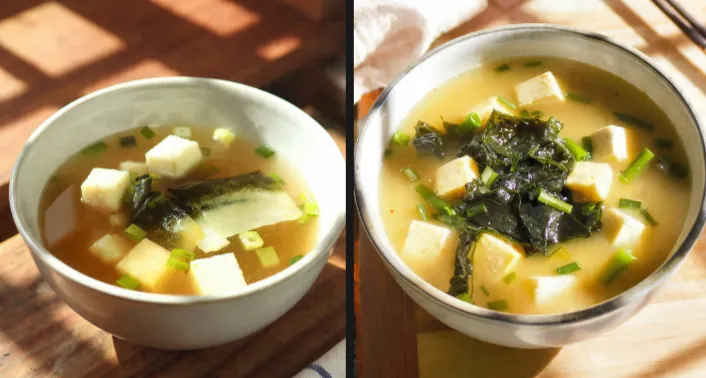Miso soup with tofu is one of the most iconic dishes in Japanese cuisine — simple, comforting, and deeply flavorful. It’s a staple in Japanese households and restaurants alike, often served as part of a traditional meal or enjoyed on its own for a light, nourishing dish. With its delicate balance of umami-rich miso, soft tofu, and fragrant seaweed, this soup embodies the essence of Japanese cooking: harmony, simplicity, and respect for ingredients.
This recipe captures the authentic flavor of miso soup while remaining easy to prepare at home. The combination of dashi broth, miso paste, tofu, and wakame seaweed creates a soup that’s both satisfying and restorative. It’s a dish that feels light yet comforting, perfect for any time of day.
The Essence of Miso Soup
The essence of miso soup lies in its umami — the savory depth that comes from fermented miso paste and dashi broth. The tofu adds a soft, creamy texture, while the seaweed and scallions bring freshness and aroma. The result is a soup that’s both simple and complex, nourishing and flavorful.
It’s a dish that reflects the Japanese philosophy of balance and mindfulness in cooking — every ingredient has a purpose, and together they create harmony in a bowl.
Why This Recipe Works
This recipe works because it respects the traditional method of making miso soup while keeping it approachable. The dashi provides a delicate base, the miso adds depth, and the tofu and seaweed give texture and nutrition. The key is to dissolve the miso gently to preserve its flavor and nutrients.
The result is a soup that’s authentic, balanced, and deeply satisfying.
Ingredients and Their Roles
Miso paste: The heart of the soup, providing umami and depth.
Dashi broth: The base that enhances the miso’s flavor.
Tofu: Adds protein and a soft, silky texture.
Wakame seaweed: Brings a subtle ocean flavor and minerals.
Scallions: Add freshness and color.
Soy sauce (optional): Enhances umami and saltiness.
Step-by-Step Recipe
Ingredients
- 4 cups dashi broth (homemade or instant)
- 3 tablespoons miso paste (white, yellow, or red)
- ½ cup cubed soft or silken tofu
- 2 tablespoons dried wakame seaweed
- 2 scallions, thinly sliced
- 1 teaspoon soy sauce (optional)
Preparation
- Prepare the dashi. In a medium pot, bring the dashi broth to a gentle simmer over medium heat.
- Add the seaweed. Stir in the dried wakame and let it rehydrate for 5 minutes.
- Add the tofu. Gently add the cubed tofu and simmer for 2–3 minutes. Do not boil, as this can break the tofu.
- Dissolve the miso. Place the miso paste in a small bowl. Add a ladleful of hot broth and whisk until smooth. Pour the mixture back into the pot and stir gently.
- Season and serve. Add soy sauce if desired. Remove from heat and garnish with sliced scallions. Serve immediately.
Tips for Perfect Miso Soup
- Never boil miso — it destroys its delicate flavor and probiotics.
- Use soft or silken tofu for a smooth texture.
- Adjust the amount of miso to taste — white miso is mild, red miso is stronger.
- Add miso at the end of cooking for the best flavor.
- Use fresh scallions for a bright finish.
Variations and Flavor Combinations
1. Classic Miso Soup
Traditional version with tofu, wakame, and scallions.
2. Mushroom Miso Soup
Add shiitake or enoki mushrooms for extra umami.
3. Vegetable Miso Soup
Add spinach, bok choy, or carrots for a heartier version.
4. Spicy Miso Soup
Add a touch of chili paste or sliced chili for heat.
5. Seafood Miso Soup
Add shrimp, clams, or fish for a richer flavor.
6. Vegan Miso Soup
Use kombu and shiitake dashi instead of fish-based dashi.
Serving Suggestions
Miso soup pairs beautifully with:
- Steamed rice and grilled fish.
- Sushi or sashimi.
- Tempura or gyoza.
- A light salad or pickled vegetables.
- Green tea or iced barley tea.
Make-Ahead and Storage
Make-ahead: The dashi can be prepared in advance and stored in the refrigerator for up to 3 days. Add miso and tofu just before serving.
Storage: Store leftover soup in an airtight container in the refrigerator for up to 2 days.
Reheating: Reheat gently over low heat. Do not boil.
Freezing: Not recommended, as tofu and miso lose texture when frozen.
Nutritional Information (per serving)**
- Calories: 120 kcal
- Protein: 8 g
- Fat: 4 g
- Carbohydrates: 10 g
- Sodium: 680 mg
The History of Miso Soup
Miso soup has been a cornerstone of Japanese cuisine for centuries. Miso itself — a fermented paste made from soybeans, rice, or barley — dates back over a thousand years. Originally introduced from China, it became a staple in Japan, where regional variations developed.
Miso soup evolved as a daily dish, often served with rice and pickles as part of a traditional Japanese breakfast. Today, it remains a symbol of comfort and nourishment, enjoyed in homes and restaurants around the world.
Texture and Flavor Profile
The perfect miso soup is light yet flavorful, with a delicate balance of umami and saltiness. The broth should be smooth and aromatic, the tofu soft and silky, and the seaweed tender. The scallions add a fresh, crisp contrast.
Each spoonful delivers warmth, depth, and a sense of calm — a reflection of Japanese culinary simplicity.
Common Mistakes and How to Avoid Them
Boiling the miso: Causes bitterness and loss of nutrients. Always add miso off the heat.
Using too much miso: Overpowers the broth. Start with less and adjust.
Skipping the dashi: Results in a flat flavor. Dashi is essential for umami.
Overcooking tofu: Makes it crumbly. Add it gently and heat briefly.
Adding miso too early: Reduces its aroma and probiotic benefits.
Chef’s Tips
- Use a fine-mesh strainer to dissolve miso smoothly.
- Add a few drops of sesame oil for richness.
- Garnish with toasted sesame seeds for texture.
- Use red miso for a stronger, more robust flavor.
- Add a few cubes of daikon radish for sweetness.
Pairing Ideas
With Drinks:
- Green tea or matcha.
- Sake or light white wine.
- Sparkling water with lemon.
With Other Dishes:
- Pair with sushi rolls or sashimi.
- Serve alongside teriyaki chicken or tofu.
- Add a side of steamed edamame or rice.
The Joy of Japanese Comfort Cooking
Miso soup with tofu embodies the joy of Japanese comfort cooking — simple, nourishing, and full of care. It’s a dish that brings warmth to the table and calm to the mind. The aroma of miso and dashi fills the kitchen with a sense of peace and tradition.
It’s proof that the most comforting meals are often the simplest, made with mindfulness and respect for ingredients.
The Science of Umami
The secret to miso soup’s depth lies in umami — the fifth taste. Miso paste and dashi both contain glutamates, natural compounds that enhance savory flavor. When combined, they create a synergy that makes the soup rich and satisfying without heaviness.
This balance of umami, salt, and subtle sweetness is what makes miso soup so addictive and comforting.
Presentation and Finishing Touches
For an elegant presentation, serve miso soup in traditional lacquer bowls. Garnish with sliced scallions, a few pieces of wakame, and a sprinkle of sesame seeds.
For a modern touch, add a drizzle of chili oil or a few drops of yuzu juice for brightness.
Modern Variations
- Keto Miso Soup: Use tofu and seaweed, skip noodles or rice.
- Low-Sodium Version: Use less miso and low-sodium soy sauce.
- Vegan Alternative: Use kombu and shiitake dashi.
- Spicy Miso Soup: Add chili paste or sriracha.
- Miso Soup with Noodles: Add soba or udon for a heartier meal.
The Perfect Comfort Meal
Miso soup with tofu is the perfect comfort meal for any occasion. It’s light, flavorful, and deeply nourishing. Whether served as a starter or a main dish, it brings warmth and serenity to every table.
It’s a dish that proves that comfort food can be both simple and elegant — a timeless classic that nourishes both body and soul.
The Cultural Influence of Miso Soup
Miso soup represents the heart of Japanese cuisine — balance, simplicity, and respect for nature. It’s a dish that connects generations, served daily in homes across Japan. Its global popularity reflects its universal appeal — a humble bowl of soup that offers comfort, nutrition, and peace.
The Role of Miso and Tofu
Miso and tofu are the soul of this soup. The miso provides depth and umami, while the tofu adds protein and texture. Together, they create a perfect harmony of flavor and nourishment.
The Perfect Spoonful
The perfect spoonful of miso soup with tofu combines silky tofu, savory broth, and tender seaweed. It’s warm, delicate, and full of umami — a bite that captures the essence of Japanese comfort cuisine.
Conclusion
Miso soup with tofu is a celebration of flavor, simplicity, and nourishment. With its savory miso broth, soft tofu, and fragrant seaweed, it’s a dish that feels both light and satisfying.
Easy to prepare yet deeply comforting, it’s perfect for any occasion. This recipe proves that with a few quality ingredients and mindful preparation, you can create a meal that’s both soothing and unforgettable — a true masterpiece of traditional Japanese home cooking.





